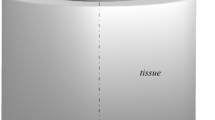Abstract
Ablation of a semi infinite medium subject to a time varying heat flux at its surface is considered. It is shown that a general integral method can be formulated to describe the post ablation solution. This method does not involve any specific approximating profile as is the case with the standard integral methods. This method, which will be referred to as the General Integral Method, yields very good solutions for problems with power law type variation in surface heat flux and also for a case where the boundary condition, involving radiation to a background, is non linear.
Zusammenfassung
Hier wird die Ablation eines halbunendlichen Mediums betrachtet, das sich einem zeitlich ändernden Wärmestrom an der Oberfläche unterwirft. Ein allgemeines Integrationsverfahren kann für die Beschreibung des Ergebnisses nach der Ablation formuliert werden. Dieses Verfahren enthält keine speziellen Näherungsprofile, wie sie bei Standardintegrationsverfahren der Fall sind. Das allgemeine Integrationsverfahren liefert sehr gute Ergebnisse für Probleme, in denen der Wandwärmestrom als Potenzfunktion beschrieben wird. Ebenso gilt dies auch für eine nicht lineare Randbedingung, wie der Strahlungsaustausch mit der Umgebung.
Similar content being viewed by others
Abbreviations
- C :
-
specific heat of medium, J/kg K
- H :
-
heat flux, W/m2
- k :
-
thermal conductivity of medium, W/m K
- L :
-
heat of sublimation of the ablating solid, J/kg
- n :
-
exponent in the surface heat flux variation with time
- P :
-
non dimensional penetration depth, after Goodman [2], defined in the text
- S :
-
non dimensional ablation layer thickness, after Goodman [2], defined in the text
- t :
-
time, s
- t r :
-
reference time, {k T p (1+n/2)1/2/H so \(\sqrt \alpha\)}(2/n+1), s
- T :
-
temperature, K
- TMF :
-
time multiplication factor, defined in the text
- x :
-
distance measured normal to the surface, m
- X :
-
thickness of material removed by ablation, m
- y :
-
non dimensional distance measured normal to the surface, (x−X)/δ
- α :
-
thermal diffusivity of medium, m2/s
- δ :
-
energy layer thickness, m
- δ′ :
-
penetration depth, m
- Δ :
-
non dimensional energy layer thickness, δ/δ p
- ζ s :
-
non dimensional surface heat flux,H s(t)/H s(t p)
- λ :
-
non dimensional ablation layer thickness,X/δ p
- λ′ :
-
normalised non dimensional ablation layer thickness, after Zien [3], λ/λ (τ→∞)
- ν :
-
reciprocal Stefan number,L/CT p
- ϱ :
-
density of the medium, kg/m3
- σ :
-
Stefan-Boltzmann constant, 5.668×10−8 W/m2 K4
- τ :
-
non dimensional time after ablation begins, (t−t p)/(t p TMF)
- τ′ :
-
non dimensional time after Zien [3],t/t r
- φ :
-
non dimensional surface temperature in the radiation problem, defined in the text
- Θ :
-
non dimensional time after Goodman [2], defined in the text
- e :
-
equilibrium condition, radiating case
- p :
-
phase change
- r :
-
reference value
- s :
-
surface value
- so :
-
amplitude of a quantity that is specified at the surface
- ∞:
-
ambient or background value in the radiating case
References
Landau, H. G.: Heat conduction in a melting solid. Quart. Appl. Math. 8 (1950) 81–94
Goodman, T. R.: Heat balance integral and its application to problems involving phase change. ASME J. Heat Transfer 80 (1958) 335–342
Zien, T. F.: Integral solutions of ablation problems with time dependent heat flux. AIAA J. 16 (1978) 1287–1295
Biot, M. A.; Aggarwal, H. C.: Variational analysis of ablation for variable properties. ASME J. Heat Transfer 86C (1964) 437–442
Vallerani, E.: Integral technique solution to a class of simple ablation problems. Meccanica 9 (1974) 94–101
Altman, M.: Some aspects of the melting solution for a semi-infinite slab. Chem. Eng. Prog. Symp. Ser. 57 (1961) 16–23
Venkateshan, S. P.; Kothari, N. S.: Approximate solution of one dimensional heat diffusion problems via hybrid profiles. Int. J. Heat & Fluid Flow 8 (1987) 243–247
Carslaw, H. S.; Jaeger, J. C.: Conduction of heat in solids (2nd ed.) London: Oxford University Press 1959
Venkateshan, S. P.; Solaiappan, O.: Approximate solution of non-linear transient heat conduction in one dimension. Wärme-Stoffübertrag. 23 (1988) 229–233
Author information
Authors and Affiliations
Rights and permissions
About this article
Cite this article
Venkateshan, S.P., Solaiappan, O. A General Integral Method for one dimensional ablation. Wärme- und Stoffübertragung 25, 141–144 (1990). https://doi.org/10.1007/BF01590144
Received:
Issue Date:
DOI: https://doi.org/10.1007/BF01590144




